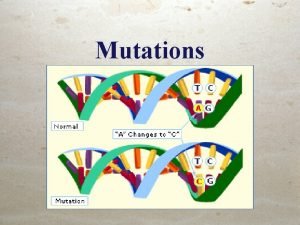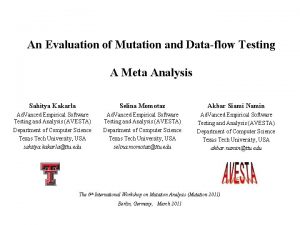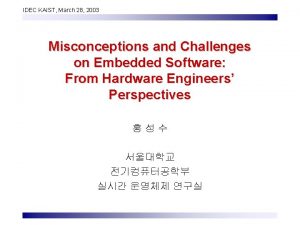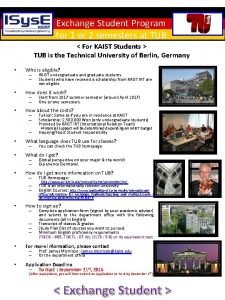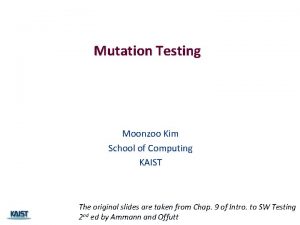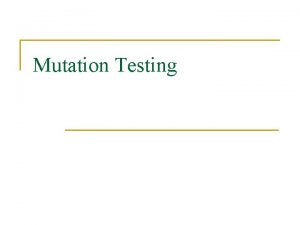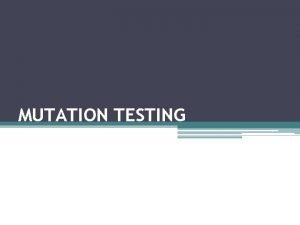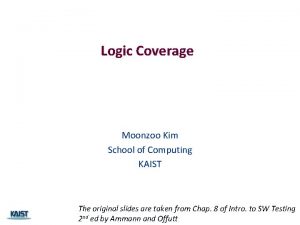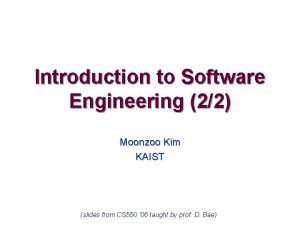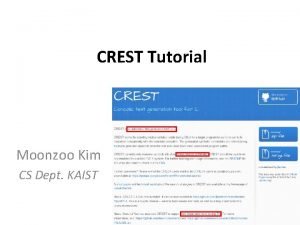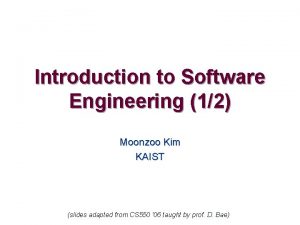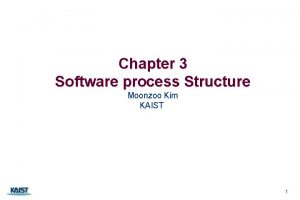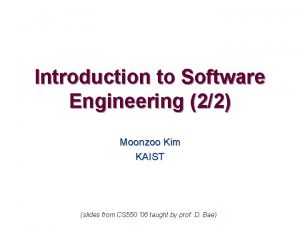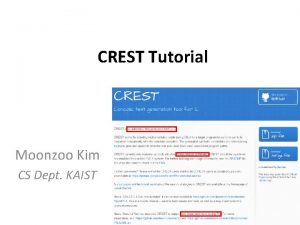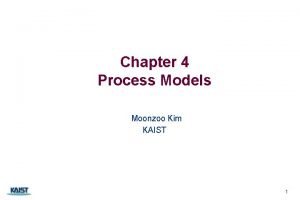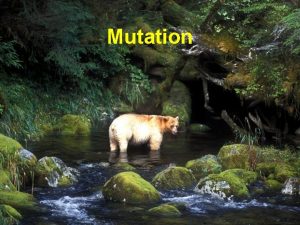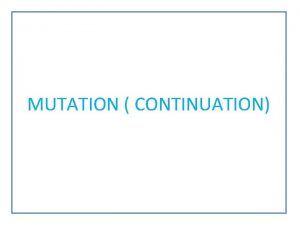Mutation Testing Moonzoo Kim School of Computing KAIST






















- Slides: 22

Mutation Testing Moonzoo Kim School of Computing KAIST The original slides are taken from Chap. 9 of Intro. to SW Testing 2 nd ed by Ammann and Offutt

Mutation Testing Operators modify a program under test to create mutant programs Mutant programs must compile correctly Mutants are not tests, but used to find good tests Once mutants are defined, tests must be found to cause mutants to fail when executed This is called “killing mutants” Most slides are taken from the text book “Introduction to Software Testing” by P. Ammann and J. Offutt

Killing Mutants Given a mutant m M for a ground string program P and a test t, t is said to kill m if and only if the output of t on P is different from the output of t on m. If mutation operators are designed well, the resulting tests will be very powerful Different operators must be defined for different programming languages and goals Testers can keep adding tests until all mutants have been killed Dead mutant : A test case has killed it Trivial mutant : Almost every test can kill it Equivalent mutant : No test can kill it (equivalent to original program) Stubborn mutant: Almost no test can kill it (a. k. a hard-to-kill mutants)

Program-based Grammars Original Method int Min (int A, int B) { int min. Val; min. Val = A; if (B < A) { min. Val = B; } return (min. Val); } // end Min 6 mutants Each represents a separate program With Embedded Mutants int Min (int A, int B) Replace one variable { with another int min. Val; min. Val = A; Changes operator ∆ 1 min. Val = B; if (B < A) Immediate runtime ∆ 2 if (B > A) failure … if reached ∆ 3 if (B < min. Val) { Immediate runtime min. Val = B; failure if B==0 else ∆4 Bomb (); does nothing ∆5 min. Val = A; ∆6 min. Val = fail. On. Zero (B); } return (min. Val); } // end Min

Syntax-Based Coverage Criteria Mutation Coverage (MC) : For each m M, TR contains exactly one requirement, to kill m. • The RIP model • Reachability : The test causes the faulty statement to be reached (in mutation – the mutated statement) • Infection : The test causes the faulty statement to result in an incorrect state • Propagation : The incorrect state propagates to incorrect output • The RIP model leads to two variants of mutation coverage …

Strong v. s. Weak Mutants 1) Strongly Killing Mutants: Given a mutant m M for a program P and a test t, t is said to strongly kill m if and only if the output of t on P is different from the output of t on m 2) Weakly Killing Mutants: Given a mutant m M that modifies a location l in a program P, and a test t, t is said to weakly kill m if and only if the state of the execution of P on t is different from the state of the execution of m immediately on t after l • Weakly killing satisfies reachability and infection, but not propagation

Equivalent Mutation Example Mutant 3 in the Min() example is equivalent: min. Val = A; if (B < A) ∆ 3 if (B < min. Val) • The infection condition is “(B < A) != (B < min. Val)” • However, the previous statement was “min. Val = A” – Substituting, we get: “(B < A) != (B < A)” – This is a logical contradiction ! • Thus no input can kill this mutant

Strong Versus Weak Mutation 1 boolean is. Even (int X) 2 { Reachability : X < 0 3 if (X < 0) 4 X = 0 - X; Infection : X != 0 ∆4 X = 0; (X = -6) will kill mutant 4 5 if (double) (X/2) == ((double) X) / 2. 0 under weak mutation 6 return (true); 7 else Propagation : 8 return (false); ((double) ((0 -X)/2) == ((double) 0 -X) / 2. 0) 9 } != ((double) (0/2) == ((double) 0) / 2. 0) That is, X is not even … Thus (X = -6) does not kill the mutant under strong mutation

Testing Programs with Mutation Prog Input test method Create mutants Run equivalence detector no Threshold reached ? Fix P no P (T) correct ? yes Generate test cases Run T on P Run mutants: • schema-based • weak • selective Eliminate ineffective TCs

Why Mutation Testing Works Fundamental Premise of Mutation Testing If the software contains a fault, there will usually be a set of mutants that can only be killed by a test case that also detects that fault Also known as “Coupling Effect” “a test data set that distinguishes all programs with simple faults is so sensitive that it will also distinguish programs with more complex faults” R. A. De. Millo, R. J. Lipton, and F. G. Sayward. Hints on test data selection: Help for the practicing programmer. Computer, 11(4), April 1978. The mutants guide the tester to an effective set of tests A very challenging problem : Find a fault and a set of mutation-adequate tests that do not find the fault Of course, this depends on the mutation operators …

Designing Mutation Operators At the method level, mutation operators for different programming languages are similar Mutation operators do one of two things : Mimic typical programmer mistakes ( incorrect variable name ) Encourage common test heuristics ( cause expressions to be 0 ) Researchers design lots of operators, then experimentally select the most useful Effective Mutation Operators If tests that are created specifically to kill mutants created by a collection of mutation operators O = {o 1, o 2, …} also kill mutants created by all remaining mutation operators with very high probability, then O defines an effective set of mutation operators

Mutation Operators 1. ABS –– Absolute Value Insertion: Each arithmetic expression (and subexpression) is modified by the functions abs(), neg. Abs(), and fail. On. Zero(). Examples: ∆1 ∆2 ∆3 a = m * (o + p); a = abs (m * (o + p)); a = m * abs ((o + p)); a = fail. On. Zero (m * (o + p)); 2. AOR –– Arithmetic Operator Replacement: Each occurrence of one of the arithmetic operators +, -, *, /, and % is replaced by each of the other operators. In addition, each is replaced by the special mutation operators left. Op, and right. Op. Examples: a = m * (o + p); ∆1 a = m + (o + p); ∆2 a = m * (o * p); ∆3 a = m left. Op (o + p);

3. ROR –– Relational Operator Replacement: Each occurrence of one of the relational operators (<, ≤, >, ≥, =, ≠) is replaced by each of the other operators and by false. Op and true. Op. Examples: if (X <= Y) ∆1 if (X > Y) ∆2 if (X < Y) ∆3 if (X false. Op Y) // always returns false 4. COR –– Conditional Operator Replacement: Each occurrence of one of the logical operators (and - &&, or - || , and with no conditional evaluation - &, or with no conditional evaluation - |, not equivalent - ^) is replaced by each of the other operators; in addition, each is replaced by false. Op, true. Op, left. Op, and right. Op. Examples: if (X <= Y && a > 0) ∆1 if (X <= Y || a > 0) ∆2 if (X <= Y left. Op a > 0) // returns result of left clause

5. SOR –– Shift Operator Replacement: Each occurrence of one of the shift operators <<, >>, and >>> is replaced by each of the other operators. In addition, each is replaced by the special mutation operator left. Op. Examples: byte b = (byte) 16; b = b >> 2; ∆1 b = b << 2; ∆2 b = b left. Op 2; // result is b 6. LOR –– Logical Operator Replacement: Each occurrence of one of the logical operators (bitwise and - &, bitwise or - |, exclusive or - ^) is replaced by each of the other operators; in addition, each is replaced by left. Op and right. Op. Examples: int a = 60; int b = 13; int c = a & b; ∆1 int c = a | b; ∆2 int c = a right. Op b; // result is b

7. ASR –– Assignment Operator Replacement: Each occurrence of one of the assignment operators (+=, -=, *=, /=, %=, &=, |=, ^=, <<=, >>>=) is replaced by each of the other operators. Examples: a = m * (o + p); ∆1 a += m * (o + p); ∆2 a *= m * (o + p); 8. UOI –– Unary Operator Insertion: Each unary operator (arithmetic +, arithmetic -, conditional !, logical ~) is inserted in front of each expression of the correct type. Examples: a = m * (o + p); ∆1 a = m * -(o + p); ∆2 a = -(m * (o + p));

9. UOD –– Unary Operator Deletion: Each unary operator (arithmetic +, arithmetic -, conditional !, logical~) is deleted. Examples: if !(X <= Y && !Z) ∆1 if (X > Y && !Z) ∆2 if !(X < Y && Z) 10. SVR –– Scalar Variable Replacement: Each variable reference is replaced by every other variable of the appropriate type that is declared in the current scope. Examples: ∆1 ∆2 ∆3 ∆4 a = m * (o + p); a = o * (o + p); a = m * (m + p); a = m * (o + o); p = m * (o + p);

11. BSR –– Bomb Statement Replacement: Each statement is replaced by a special Bomb() function. Example: a = m * (o + p); ∆1 Bomb() // Raises exception when reached

Coupling Effects

Mutants Selection Strategies

Mutation Tools C programming language Proteum Milu MUSIC Java Wrench

Summary : Subsumption of Other Criteria Mutation is widely considered the strongest test criterion And most expensive ! By far the most test requirements (each mutant) Not always the most tests Mutation subsumes other criteria by including specific mutation operators Subsumption can only be defined for weak mutation – other criteria impose local requirements, like weak mutation Node coverage Edge coverage Clause coverage All-defs data flow coverage Reference: An Analysis and Survey of the Development of Mutation Testing by Y. Jia et al. IEEE Transactions on Software Engineering Volume: 37 Issue: 5 Design Of Mutant Operators For The C Programming Language by H. Agrawal et al. Technical report

Bug Observability/Detection Model: Reachability, Infection, Propagation, and Revealation (RIPR) Terminology Graph coverage Test requirement satisfaction == Reachability Fault: static defect in a the fault in the code has to be reached program text (a. k. a a bug) Logic coverage Error: dynamic Test requirement satisfaction (intermediate) behavior == Reachability +Infection that deviates from its the fault has to put the program into an error state. (internal) intended goal A fault causes an error (i. e. error is a symptom of fault) Failiure: dynamic behavior which violates a ultimate goal of a target program Not every error leads to failure due to error masking or fault tolerance Note that a program is in an error state does not mean that it will always produce the failure Mutation coverage Test requirement satisfaction == Reachability +Infection + Propagation the program needs to exhibit incorrect outputs Furthermore, test oracle plays critical role to reveal failure of a target program (Revealation)
 Any mistake or change in the dna sequence
Any mistake or change in the dna sequence Data flow and mutation testing
Data flow and mutation testing Klms kaist
Klms kaist Kaist research internship
Kaist research internship Nuclear and quantum engineering
Nuclear and quantum engineering Computer science kaist
Computer science kaist Kaist internship
Kaist internship 서효원 교수
서효원 교수 Kaist
Kaist Web erp kaist
Web erp kaist Kaist exchange program
Kaist exchange program Conventional computing and intelligent computing
Conventional computing and intelligent computing What is domain
What is domain Kv charts in software testing
Kv charts in software testing Du path testing
Du path testing Positive testing and negative testing
Positive testing and negative testing Cs3250
Cs3250 Globalization testing
Globalization testing Neighborhood integration testing
Neighborhood integration testing Language testing
Language testing Control structure testing in software engineering
Control structure testing in software engineering Decision table testing in software testing
Decision table testing in software testing Decision table testing example
Decision table testing example
